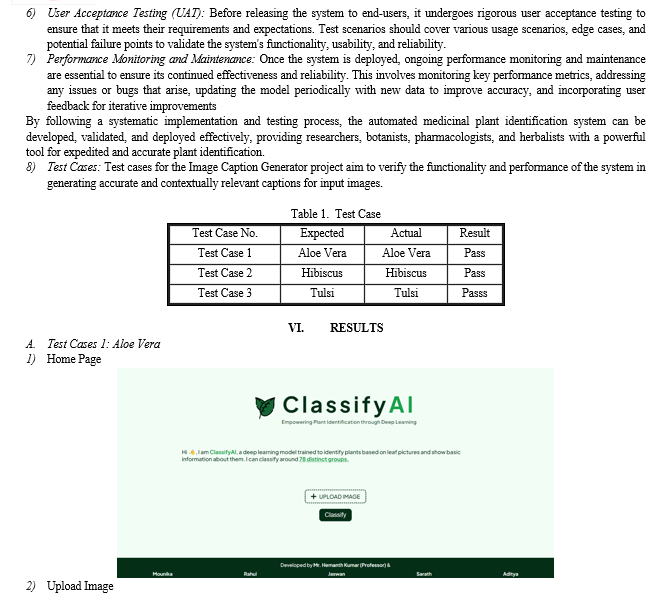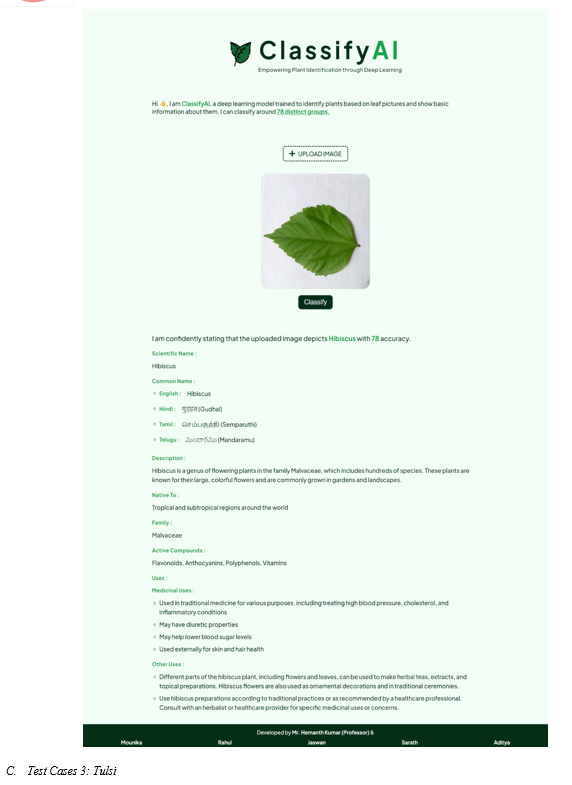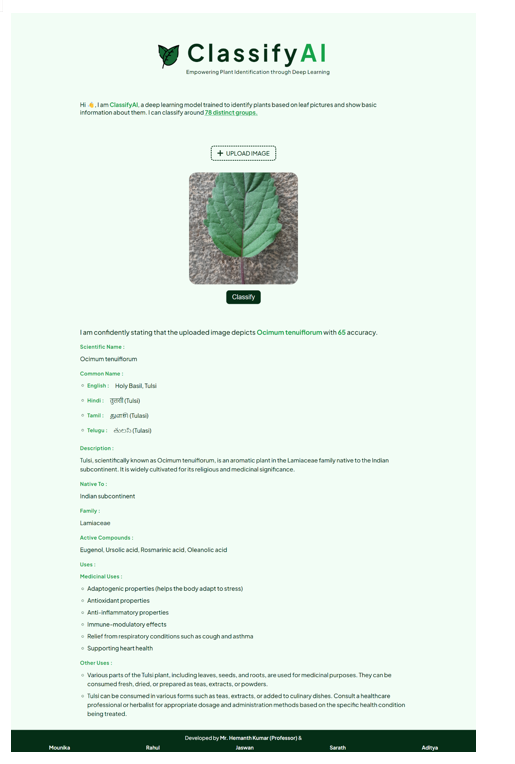Ijraset Journal For Research in Applied Science and Engineering Technology
- Home / Ijraset
- On This Page
- Abstract
- Introduction
- Conclusion
- References
- Copyright
Automated Medicinal Plant Identification and Use Case Generation: A Convolutional Neural Network-Xception Approach
Authors: V Hemanth Kumar, Jaswan Reddy CH, Godaba Rahul, Vavilapalli Mounika, K Sarath Sai, Pedapati Aditya
DOI Link: https://doi.org/10.22214/ijraset.2024.60235
Certificate: View Certificate
Abstract
In the realm of botany, pharmacology, and herbal medicine, the identification of medicinal plants stands as a crucial yet labor-intensive endeavor. This project presents a pioneering approach to automate plant identification through the utilization of advanced deep learning techniques, specifically employing the Xception architecture within a Convolutional Neural Network (CNN). The methodology involves the acquisition of plant images, followed by preprocessing and dimension reduction to 299x299 pixels. Subsequently, the model undergoes rigorous training, achieving commendable accuracies of approximately 85% in training, 93% in validation, and 94% in testing phases. The trained model is then deployed through a user-friendly web interface, allowing seamless interaction for uploading images and receiving comprehensive plant classification results. Leveraging Flask for backend integration, this system bridges the gap between cutting-edge technology and botanical expertise, enabling researchers, botanists, pharmacologists, and herbalists to expedite plant identification processes with heightened accuracy and efficiency. Furthermore, this innovation not only streamlines identification tasks but also provides detailed insights into the diverse applications and attributes of medicinal plants, thereby fostering advancements in research, conservation, and utilization for the betterment of human health and well-being..
Introduction
I. INTRODUCTION
In the realms of botany, pharmacology, and herbal medicine, accurate identification of medicinal plants is paramount for understanding their therapeutic potential and applications. Traditional methods often rely on manual observation, which can be time-consuming and prone to errors. Addressing this challenge, a pioneering project introduces an automated system leveraging advanced technology, particularly deep convolutional neural networks (CNNs) such as the Xception architecture. This system aims to revolutionize plant identification by efficiently processing images of medicinal plants, reducing dimensions, and employing trained models to classify them accurately. By automating this process, the project accelerates identification, enhances accuracy, and caters to the needs of researchers, botanists, pharmacologists, and herbalists, thereby facilitating expedited research and application in the field of herbal medicine.
This innovative approach represents a significant leap in integrating advanced technology with botanical expertise. By providing comprehensive details about identified medicinal plants, including botanical names and use cases, the system serves as a valuable tool for research, conservation, and utilization of medicinal flora. Its contributions extend to the enhancement of human health and well-being, promising to advance the fields of botany, pharmacology, and herbal medicine through streamlined processes and more accurate insights into the therapeutic potential of plant species.
II. LITERATURE SURVEY
- An AI Based Approach for Medicinal Plant Identification Using Deep CNN Based on Global Average Pooling
Authors: Rahim Azadnia, Mohammed Maitham Al-Amidi, Hamed Mohammadi, Mehmet Akif Cifci, Avat Daryab, Eugenio Cavallo
Presented at MDPI journals in 2022, this paper introduces a novel AI-based approach for medicinal plant identification using deep convolutional neural networks (CNNs) with a focus on Global Average Pooling (GAP). The CNN architecture incorporates convolutional blocks followed by a classifier block, where GAP replaces Fully Connected layers to mitigate overfitting.
The study utilizes images of five medicinal plant species and achieves high accuracy rates of up to 99.66%, demonstrating the efficacy of the proposed methodology in plant species recognition and classification.
2. Identification of Medicinal Plants using Deep Learning
Authors: R. Upendar Rao, M. Sai Lahari, K. Pavana Sri, K. Yaminee Srujana, D. Yaswanth
Published in the International Journal for Research in Applied Science & Engineering Technology (IJRASET) in 2022, this paper focuses on the identification of medicinal plants through deep learning techniques. The study employs DenseNet CNN models trained on leaf samples of various medicinal plant species, achieving training accuracy of 91.6% and test accuracy of 84.1%. By leveraging deep learning methodologies, the paper contributes to the automated identification of medicinal plants, addressing the need for efficient and accurate classification systems in botanical research.
3. Medicinal Plant Recognition based on CNN and Machine Learning
Authors: Bhanuprakash Dudi, Dr. V. Rajesh
Presented in the International Journal of Advanced Trends in Computer Science and Engineering in 2019, this paper explores medicinal plant recognition using CNN and machine learning techniques. The study employs preprocessing techniques such as resizing and normalization, coupled with CNN architectures and machine learning algorithms (ANN, SVM, KNN, Naive Bayes), to extract features and classify medicinal plant species. With the Flavia dataset, the proposed approach achieves an impressive accuracy of 98%, demonstrating its efficacy in medicinal plant recognition tasks.
4. Identification and classification of medicinal plants using leaf with deep convolutional neural networks
Authors: Nilesh S. Bhelkar, Dr. Avinash Sharma
Published in the International Journal of Health Sciences in 2022, this paper presents a CNN-based approach for the identification and classification of medicinal plants. The study utilizes a convolutional neural network architecture, specifically the Xception model, trained on leaf images of 45 distinct medicinal plant species. With a training accuracy of 98.40% and validation accuracy of 97.65%, the proposed model demonstrates high accuracy in medicinal plant classification tasks, contributing to advancements in plant species recognition and classification.
5. Classification and identification of medicinal plants found in Sikkim
Authors: Adarsh Chettri, Dr. Om Prakash Sharma
This paper, published in 2022, focuses on the classification and identification of medicinal plants found in Sikkim. Utilizing CNN models, the study achieves an accuracy of 95.314% in identifying medicinal plant species. By leveraging datasets collected from Mendeley Data, the paper contributes to the development of automated systems for the recognition and classification of medicinal flora, addressing the need for efficient plant identification methods in botanical research and conservation efforts.
III. ANALYSIS
A. Existing System
Traditional methods of identifying medicinal plants rely heavily on manual observation, reference materials, and chemical analysis by experts in botany, pharmacology, and herbalism. However, these approaches are time-consuming, subjective, and prone to human error, limiting their scalability and accessibility to non-experts. To address these limitations, there's a growing demand for automated solutions using technologies like machine learning and computer vision, promising faster, more accurate, and scalable identification processes.
A comprehensive review of existing methods for medicinal plant identification reveals diverse approaches and technological foundations. Traditional methods, documented in research papers such as those by Nilesh S. Bhelkar et al. and Izwan Asraf Md Zin et al., rely on manual observation and reference materials but suffer from subjectivity and time constraints. Recent advancements in deep learning, particularly convolutional neural networks (CNNs), showcased in studies like that of Rahim Azadnia et al. and R. Upendar Rao et al., offer promising automated solutions with high accuracy based on leaf images. Integration of advanced techniques like attention mechanisms, as demonstrated by Kelvin Xu et al., and hybrid approaches combining CNNs with machine learning algorithms, as explored by Bhanuprakash Dudi et al., further improve identification performance. Overall, the transition towards data-driven and technology-driven solutions underscores the evolving landscape of medicinal plant identification, aiming to enhance accuracy, efficiency, and accessibility in botanical research and application.
B. Proposed System
The proposed system presents an innovative approach to medicinal plant identification, leveraging cutting-edge technologies in machine learning and computer vision. Building upon the limitations of existing methods, the proposed system aims to revolutionize the process of plant recognition by introducing automated and scalable solutions. Inspired by advancements in deep learning, particularly convolutional neural networks (CNNs), the proposed system adopts a CNN architecture, specifically the Xception model, as its backbone.
The Xception model, as described in literature such as "Identification and classification of medicinal plants using leaf with deep convolutional neural networks" by Nilesh S. Bhelkar et al., offers efficient parameter utilization and enhanced feature extraction capabilities, making it well-suited for complex image classification tasks. By harnessing the power of depth-wise separable convolutions, the Xception architecture optimally captures spatial hierarchies in data, enabling robust learning of intricate relationships within medicinal plant images. Moreover, the proposed system integrates data augmentation techniques such as rotation, flipping, and resizing, as highlighted in "Herbal plant recognition using deep convolutional neural network" by Izwan Asraf Md Zin et al. These techniques enhance the diversity and richness of the training dataset, thereby improving the generalization and robustness of the model.
Furthermore, the system implements transfer learning capabilities, allowing for the utilization of pre-trained models on large datasets, as demonstrated in "Medicinal Plant Identification Using Deep Learning" by R. Geerthana et al. This approach reduces overfitting tendencies and accelerates model convergence, particularly beneficial for projects with limited labeled data. Overall, the proposed system represents a significant advancement in the field of medicinal plant identification, offering a comprehensive and automated solution that combines state-of-the-art deep learning techniques with botanical expertise. By addressing the shortcomings of existing methods and leveraging the latest advancements in technology, the proposed system holds promise for enhancing accuracy, efficiency, and accessibility in medicinal plant recognition tasks.
C. Feasibility Description
Before proceeding with the implementation of the proposed automated medicinal plant identification system, a comprehensive feasibility study is essential to evaluate its viability across different aspects. From a technical standpoint, the required technologies, such as Python, TensorFlow, Flask, HTML, CSS, and JavaScript, are readily available and well-supported, ensuring technical feasibility. Additionally, the hardware specifications, including an Intel i5 processor, 8GB RAM, and an NVIDIA discrete graphics card, meet the computational demands of the system, further confirming its technical feasibility.
Operational feasibility considers user acceptance and ease of use. Given the strong interest among researchers, botanists, pharmacologists, and herbalists in simplifying the plant identification process, the system is expected to be readily accepted by its target users. Furthermore, the user-friendly web interface designed for simplicity enhances operational feasibility, ensuring that users can easily navigate and utilize the system.
Economic feasibility involves analyzing costs and potential returns on investment (ROI). While development and maintenance costs, as well as potential licensing fees, are factors to consider, the anticipated benefits in terms of time-saving and efficiency improvement justify the investment, indicating economic feasibility. The automation of plant identification is expected to yield significant ROI through time savings and enhanced productivity. In conclusion, based on the outcomes of the feasibility study across these dimensions, it's evident that the proposed automated medicinal plant identification system is feasible for development and implementation. However, ongoing monitoring and evaluation will be necessary throughout the project lifecycle to address any emerging challenges and ensure continued feasibility.
IV. MODULE DESCRIPTION
The automated medicinal plant identification system can be divided into several modules, each responsible for specific tasks within the overall workflow. Here's a breakdown of the module description:
- Image Acquisition Module: This module is responsible for acquiring plant images from various sources, such as digital cameras, smartphones, or online databases. It may include functionalities for image capturing, uploading, and preprocessing to ensure uniformity and compatibility with the subsequent processing steps.
- Preprocessing Module: Once the images are acquired, they undergo preprocessing to enhance their quality and prepare them for feature extraction and classification. Preprocessing techniques may include resizing, normalization, noise reduction, and contrast adjustment to standardize the input images for the model.
- Feature Extraction Module: In this module, features are extracted from the preprocessed images to represent the unique characteristics of each plant species. This may involve techniques such as convolutional neural networks (CNNs) to automatically learn discriminative features from the images or handcrafted feature extraction methods based on domain knowledge.
- Model Training Module: The extracted features are used to train a machine learning model, such as a CNN, for medicinal plant classification. This module involves partitioning the dataset into training, validation, and testing sets, selecting an appropriate architecture for the model (e.g., Xception), fine-tuning model hyperparameters, and optimizing performance metrics through iterative training iterations.
- Validation Module: Once the model is trained, it is evaluated using a separate validation dataset to assess its performance and generalization ability. This module involves calculating performance metrics such as accuracy, precision, recall, and F1-score to validate the effectiveness of the trained model.
- Testing Module: After validation, the model is subjected to testing using unseen data to evaluate its performance in real-world scenarios. This module involves feeding new plant images through the model and analyzing its classification accuracy and robustness against different environmental conditions and variations in plant appearance.
- Deployment Module: Once the model is successfully trained and tested, it is deployed into a production environment for end-users to access. This module involves integrating the trained model with a user-friendly web interface or mobile application, implementing backend infrastructure for handling user requests, and ensuring scalability, security, and reliability of the deployed system.
- Maintenance and Monitoring Module: After deployment, the system requires ongoing maintenance and monitoring to ensure its continued effectiveness and reliability. This module involves monitoring system performance, addressing any issues or bugs that arise, updating the model periodically with new data or improvements, and incorporating user feedback for iterative enhancements.
By organizing the medicinal plant identification system into modular components, each responsible for specific tasks, the development, deployment, and maintenance of the system can be managed more effectively, leading to a robust and reliable solution for plant identification in various applications.






Conclusion
VII. CONCLUSION AND FUTURE SCOPE In conclusion, the automated medicinal plant identification system marks a significant advancement in botany, pharmacology, and herbal medicine. By utilizing deep convolutional neural networks, particularly the Xception architecture, the system streamlines identification and provides valuable insights into medicinal plants\' diverse applications. This integration of advanced technology with botanical expertise accelerates identification and improves accuracy, facilitating expedited research and application in herbal medicine. Looking forward, there are several opportunities for enhancement. Expanding the dataset to include more medicinal plant species would enhance the model\'s accuracy. Additionally, fine-tuning the model\'s parameters and exploring different deep learning techniques could further improve performance. Integrating features like plant morphology analysis and geographical distribution mapping would enrich the system\'s capabilities, while developing a mobile application version would enhance accessibility. Collaboration with experts in botany, research, and healthcare can enrich the system\'s knowledge base and ensure its relevance in real-world scenarios. In essence, the proposed system lays a strong foundation for transformative advancements in herbal medicine. Through innovation, collaboration, and ongoing refinement, we can harness the therapeutic potential of medicinal plants to benefit humanity.
References
[1] Xu, K., Ba, J., Kiros, R., Cho, K., Courville, A., Salakhudinov, R., Zemel, R., & Bengio, Y. (2015). Show, Attend and Tell: Neural Image Caption Generation with Visual Attention. In *Proceedings of the 32nd International Conference on Machine Learning (ICML)*. [2] Azadnia, R., Al-Amidi, M. M., Mohammadi, H., Cifci, M. A., Daryab, A., & Cavallo, E. (2022). An AI Based Approach for Medicinal Plant Identification Using Deep CNN Based on Global Average Pooling. *MDPI Journals*. [3] Rao, R. U., Lahari, M. S., Sri, K. P., Srujana, K. Y., & Yaswanth, D. (2022). Identification of Medicinal Plants using Deep Learning. *International Journal for Research in Applied Science & Engineering Technology (IJRASET)*. [4] Dudi, B., & Rajesh, V. (2019). Medicinal Plant Recognition based on CNN and Machine Learning. *International Journal of Advanced Trends in Computer Science and Engineering*. [5] Bhelkar, N. S., & Sharma, A. (2022). Identification and classification of medicinal plants using leaf with deep convolutional neural networks. *International Journal of Health Sciences*. [6] Chettri, A., & Sharma, O. P. (2022). Classification and identification of medicinal plants found in Sikkim. [7] Zin, I. A. M., Ibrahim, Z., Isa, D., Aliman, S., Sabri, N., & Mangshor, N. N. A. (2020). Herbal plant recognition using deep convolutional neural network. *Bulletin of Electrical Engineering and Informatics*. [8] Kumar, K. (2021). Identification of Ayurvedic Medicinal Leaves Using Deep Learning. *JETIR*. [9] Bhelkar, N., Sharma, A., & Patil, M. (2023). Medicinal Plant Classification Using a Convolutional Neural Network. [10] Geerthana, R., Nandhini, P., & Suriyakala, R. (2021). Medicinal Plant Identification Using Deep Learning. *International Research Journal on Advance Science Hub*.
Copyright
Copyright © 2024 V Hemanth Kumar, Jaswan Reddy CH, Godaba Rahul, Vavilapalli Mounika, K Sarath Sai, Pedapati Aditya. This is an open access article distributed under the Creative Commons Attribution License, which permits unrestricted use, distribution, and reproduction in any medium, provided the original work is properly cited.

Download Paper
Paper Id : IJRASET60235
Publish Date : 2024-04-12
ISSN : 2321-9653
Publisher Name : IJRASET
DOI Link : Click Here
 Submit Paper Online
Submit Paper Online

